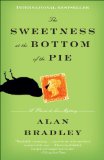Summary | Excerpt | Reading Guide | Reviews | Beyond the Book | Readalikes | Genres & Themes | Author Bio

I leapt up from the table and fled the room in tears. I didn't actually think of the poison until next morning at breakfast.
As with all great schemes, it was a simple one.
Buckshaw had been the home of our family, the de Luces, since time out of mind. The present Georgian house had been built to replace an Elizabethan original burnt to the ground by villagers who suspected the de Luces of Orange sympathies. That we had been ardent Catholics for four hundred years, and remained so, meant nothing to the inflamed citizenry of Bishop's Lacey. "Old House," as it was called, had gone up in flames, and the new house which had replaced it was now well into its third century.
Two later de Luce ancestors, Antony and William de Luce, who had disagreed about the Crimean War, had spoiled the lines of the original structure. Each of them had subsequently added a wing, William the east wing and Antony the west.
Each became a recluse in his own dominion, and each had forbidden the other ever to set foot across the black line which they caused to be painted dead center from the vestibule in the front, across the foyer, and straight through to the butler's W.C. behind the back stairs. Their two yellow brick annexes, pustulantly Victorian, folded back like the pinioned wings of a boneyard angel which, to my eyes, gave the tall windows and shutters of Buckshaw's Georgian front the prim and surprised look of an old maid whose bun is too tight.
A later de Luce, Tarquin—or Tar, as he was called—in the wake of a sensational mental breakdown, made a shambles of what had promised to be a brilliant career in chemistry, and was sent down from Oxford in the summer of Queen Victoria's Silver Jubilee.
Tar's indulgent father, solicitous of the lad's uncertain health, had spared no expense in outfitting a laboratory on the top floor of Buckshaw's east wing: a laboratory replete with German glassware, German microscopes, a German spectroscope, brass chemical balances from Lucerne, and a complexly shaped mouth-blown German Geisler tube to which Tar could attach electrical coils to study the way in which various gases fluoresce.
On a desk by the windows was a Leitz microscope, whose brass still shone with the same warm luxury as it had the day it was brought by pony cart from the train at Buckshaw Halt. Its reflecting mirror could be angled to catch the first pale rays of the morning sun, while for cloudy days or for use after dark, it was equipped with a paraffin microscope lamp by Davidson & Co. of London.
There was even an articulated human skeleton on a wheeled stand, given to Tar when he was only twelve by the great naturalist Frank Buckland, whose father had eaten the mummified heart of King Louis XIV.
Three walls of this room were lined from floor to ceiling with glass-fronted cabinets, two of them filled row upon row with chemicals in glass apothecary jars, each labeled in the meticulous copperplate handwriting of Tar de Luce, who in the end had thwarted Fate and outlived them all. He died in 1928 at the age of sixty in the midst of his chemical kingdom, where he was found one morning by his housekeeper, one of his dead eyes still peering sightlessly through his beloved Leitz. It was rumored that he had been studying the first-order decomposition of nitrogen pentoxide. If that was true, it was the first recorded research into a reaction which was to lead eventually to the development of the A-bomb.
Uncle Tar's laboratory had been locked up and preserved in airless silence, down through the dusty years until what Father called my "strange talents" had begun to manifest themselves, and I had been able to claim it for my own.
I still shivered with joy whenever I thought of the rainy autumn day that Chemistry had fallen into my life.
I had been scaling the bookcases in the library, pretending I was a noted Alpinist, when my foot slipped and a heavy book was knocked to the floor. As I picked it up to straighten its creased pages, I saw that it was filled not just with words, but with dozens of drawings as well. In some of them, disembodied hands poured liquids into curiously made glass containers that looked as if they might have been musical instruments from another world.
Excerpted from The Sweetness at the Bottom of the Pie by Alan Bradley Copyright © 2009 by Alan Bradley. Excerpted by permission of Delacorte Press, a division of Random House, Inc. All rights reserved. No part of this excerpt may be reproduced or reprinted without permission in writing from the publisher
Your guide toexceptional books
BookBrowse seeks out and recommends the best in contemporary fiction and nonfiction—books that not only engage and entertain but also deepen our understanding of ourselves and the world around us.